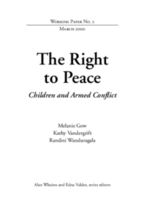Children today are increasingly deliberate targets, as well as unintended victims, in armed conflicts around the world. Between 1985 and 1995:
- 2 million children were killed;
- 6 million were left seriously injured or permanently disabled;
- 12 million were left homeless;
- 1 million were orphaned or separated from their parents;
- 10 million suffered from serious psycho-logical trauma as a result of war; and
- 300,000 served as child soldiers.
World Vision believes that the protection of all children from armed conflict is essential, and addresses this concern through four avenues:
- humanitarian assistance to children during and after conflict,
- child-focused community-development work which helps to address some causes of war,
- peacebuilding and reconciliation activities in conflict-prone and post-conflict situations, and
- advocacy to improve public policies and practices that impact children.
In the ongoing search for effective strategies to address the issue of children affected by war, this discussion of recommendations is addressed to national governments and international organisations, and focuses on practical steps within a comprehensive approach. World Vision believes that the Convention on the Rights of the Child (CRC) provides a positive framework for action. The CRC combines a recognition of the responsibility of adults to protect children and adolescents with the right and responsibility of young people to participate in their own development.
Within that framework, implementation of the recommendations of the Graca Machel report The Impact of Armed Conflict on Children (submitted to the General Assembly of the UN in 1996) is a high priority. This working paper recommends additional steps to strengthen compliance and public accountability for respecting the rights of children.
Children need not be merely victims of war; they, along with their families and communities, can be active participants in the prevention of conflict and in the development or rebuilding of their countries. World Vision advocates a comprehensive strategy which will:
- prevent the involvement of children in armed conflict;
- protect children from the impact of armed conflict when it occurs;
- practice child-focused post-conflict reconciliation and reconstruction and;
- promote the active participation of children and their families at every step.
©World Vision International

